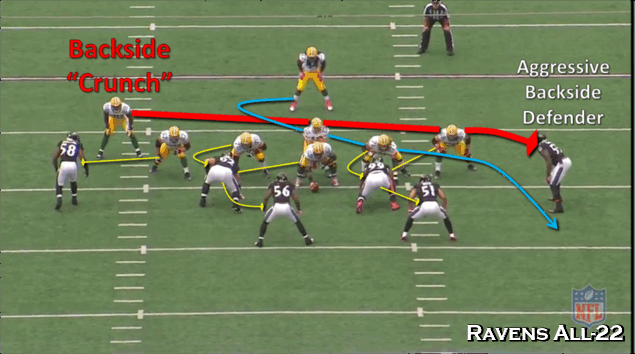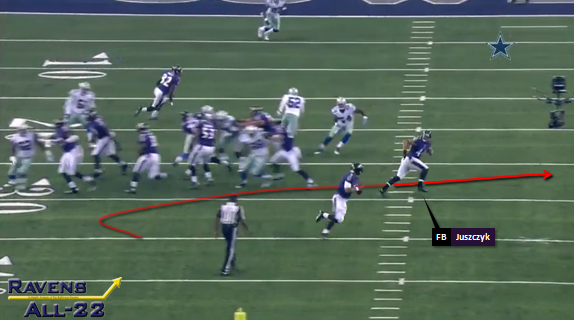Coming out of college, fans were excited about his versatility - although many were perplexed as to why a franchise would select any fullback with the 130th pick in the draft.
In spite of this conjecture, we can assume that Juszczyk will get far more snaps this coming season compared to the four he received in 2013. That's because his skill set - if used properly - can give the Ravens offense the extra edge it needs to compete for an AFC North title.
Juszczyk adds a schematic edge in the zone running game
We know that the Ravens will use the zone blocking scheme as their base rushing attack under new offensive coordinator Gary Kubiak.
Yet the zone run game is not a new concept to the Ravens, as they used this scheme on ~70% of their run plays last season. One of the biggest changes will be inserting Kyle Juszczyk, which provides a number of advantages that can improve the rushing attack from last season.
I've written before about the blocking tactics needed to run the zone rushing scheme, but in short, the offensive linemen need to be able to "combination" block effectively. That means double-teaming a first level defender (down lineman) until one of the offensive linemen gain enough leverage to allow his teammate to scoop up to the second level (linebackers).
Combination blocks are hard to master, particularly because they necessitate good communication and confidence in the system. Both of these aspects were lacking last season and, coupled with personnel who played far below average (e.g. Shipley, Gradkowski, Oher), it was no surprise that the Ravens managed one of the worst rushing performances in history. But this coming season, the Ravens have Juszczyk, a weapon who, if used correctly, will enhance the already-improved offensive line.
Below is a play from the Ravens first preseason game in 2014:
With Juszczyk in the game as a part of the Ravens 21 personnel, the offensive line is only responsible for one combination block rather than two (or more). Against an 8-man box (eighth defender just off the image to the right) Juszczyk's blocking assignment is #50 Chris Borland.
With the majority of the defenders accounted for via man blocks and the lone combination block (red) being executed properly, Juszczyk can lead RB Bernard Pierce through the A gap.
The Ravens offensive line has made improvements by getting Osemele back from injury and adding Zuttah, but fans remain understandably cautious. An additional scheme wrinkle should quell some more of their fears.
Question: The Ravens had veteran fullback Vonta Leach on the team last year. So why didn't this zone lead scheme work last season?
Answer: Kyle Juszczyk's versatility in the pass game means the defense can't rely on the fullback as their lone run key. Here's what I mean:
The Ravens are in the same formation as the play before. However, instead of running behind Juszczyk to the weak side (left), the playcall is Outside Zone Strong (right; blue). Again, there is only one combination block (in red) needed to execute this play.
RG Marshal Yanda and RT Rick Wagner (red) have driven the first level player off the line of scrimmage prior to Yanda climbing to the second level linebacker. Juszczyk is working his assigned block on LB Chris Borland (again).
Instead of Juszczyk blocking Borland though, he releases up the seam as Flacco's primary read after play-faking to RB Bernard Pierce.
The NFL play-action game is not as tied to run game success as many fans think. Much of the success of play-action comes from putting pressure on specific players to force them to hesitate and/or read false run keys. The imagination of the Kubiak rushing attack can open up a number of down-field options.
Adding another schematic wrinkle by manipulating the backside defender in the zone blocking scheme
Gary Kubiak's zone rushing philosophy doesn't work simply because of efficient execution by his offensive line and running backs. On its own, the zone rushing attack isn't difficult to stop by simply flowing stronger to the play-side (side of the run) and overwhelming the offensive line by taking up all of the gaps. This defensive approach often entails the backside (often unblocked) line of scrimmage defender to crash down and minimize cut-back lanes.
A simple way to account for this backside defender is to use the "split zone" concept.
Briefly, an H-back (for the Ravens, Juszczyk) pulls across the formation to block the cut-back defender and keep him from impacting the play:
Kyle Juszczyk would play the Jermichael Finley (red) role in the GIF above, using what some call a "bim" block (or "crunch") to keep the cut-back player from crashing down the line of scrimmage. This play has similarities to the Wham play.
Importantly, the Ravens have shown split zone tendencies during the preseason and especially during the open practice at M&T Bank Stadium that I was able to attend. Kubiak has shown comfort in using multiple players to collision the backside defender including Pitta, Steve Smith, and of course Juszczyk.
Split zone can utilize Juszczyk's blocking prowess, but Ravens fans know that he's more than a standard road grader. Therefore, pulling Juszczyk across the formation can also open passing lanes in the "Swap Boot" concept:
This play comes from the Ravens second preseason game. The Ravens are aligned in a "Weak I" formation with Juszczyk as the fullback. Given Juszczyk's recent proclivity toward blocking second-level linebackers (dashed white), Dallas is sensibly preparing for an Inside Zone Weak (left) play-call.
However, Juszczyk leans toward the weak side, only to release "under" the line of scrimmage into the far flat for an easy reception. As you can see, even after Juszczyk emerges into his route, the defense is flowing the opposite direction.
Conclusion
Tying together 2-back zone with the play-action seam as well as combining "split zone" with "swap boot" adds a level of complexity for defenses to prepare for. The flexibility of Juszczyk in the Kubiak system can put multiple defenders into scenarios where they are thinking rather than being instinctual. If the Ravens offense can keep its opponents from anticipating the play and force them to hesitate, it opens up the field for it's other weapons.










No comments:
Post a Comment